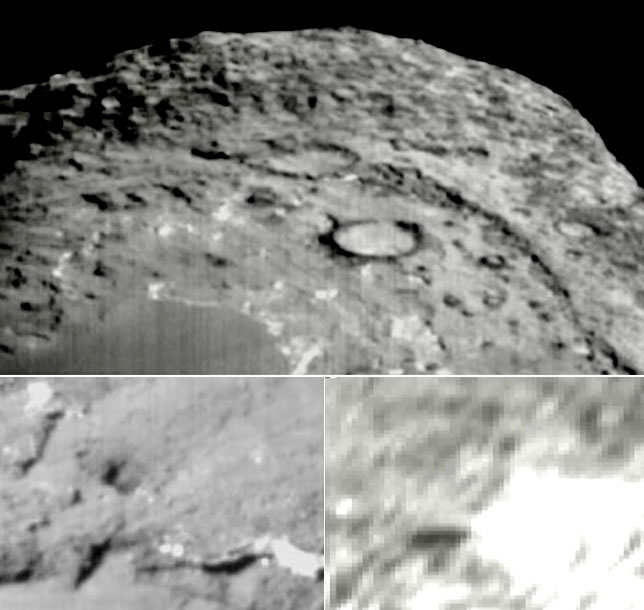|

by Wallace Thornhill
Jul 08, 2005
from
Thunderbolts Website

Credit:
NASA/JPL--Caltech/UMD
We’ll hold off on a celebration for now,
but the pictures above appear to exhibit some of the “smoking guns”
that the electric theorists have predicted.
The single most dramatic prediction of the electric comet model is
this: on close inspection an active comet nucleus will reveal the
electrical arcs that progressively etch away the surface and
accelerate material into space. From the electrical vantage point,
Tempel 1 is a “low voltage comet”, but the etching process appears
to be sufficiently active to make our case.
The white spots were noticed by the Thunderbolts crew as soon as the
first pictures were released, and we offered an interpretation: they
are small electric arcs analogous to the discharge plumes on
Jupiter’s moon Io, and to the electrified dust devils on Mars.
On
July 6 we drew attention to an earlier Picture of the Day observing
bright spots on Wild 2. There we suggested that these were the
patches of electric discharge at the surface. Now, with the help of
the Deep Impact images, that interpretation is further illuminated
and strengthened.
In addressing these fuzzy white areas in one of the pictures taken
by the projectile prior to impact, NASA reports,
“The bright patches
in the image may consist of very smooth and reflective material, the
composition of which will be determined by Deep Impact's
spectrometer”.
NASA’s observations came two days after impact, and the language
used invites us to make further predictions. The patches will have
nothing to do with “reflectivity”. They are better explained as the
light of focused glow discharges, showing up as fuzzy whiteouts.
They are the cometary equivalent to “St. Elmo’s fire” – coronal glow
discharges sometimes observed dancing on high points in lightning
storms on Earth.
Similar, but more powerful arcs on Jupiter’s moon
Io produced whiteouts that overloaded the Galileo probe camera and
surprised the investigators. These discharges on the comet’s surface
should show emission lines from ionized surface material and be
emitting ultraviolet light (something that arc welders know
well—it’s why they wear welder’s masks and protective clothing).
And if the instruments on either the projectile or the spacecraft
obtained measurements at sufficient resolution to detect
unexpectedly high temperatures at the point source, NASA
investigators will be in for quite a surprise. Electric arcs are
hot!
Does NASA have the required data buried in the transmissions from
Deep Impact?
One reason for cautious optimism is the size of the
whiteouts in the last pictures taken before the projectile’s
camera’s shut down some 18 miles above the surface. (The very last
picture is seen in the lower right). Both ultraviolet light
emissions and “shocking” temperatures within the white spots would
be definitive evidence for the electrical nature of comets.
When researchers investigating the Electric Universe express
enthusiasm for comet study, a point of particular interest is the
possibility that, by observing electrical arcing in action, we could
see more clearly the relationship to the geology-in-formation on the
comet nucleus.
Several years ago, Wallace Thornhill accurately predicted what
Galileo investigators would find when they looked at the “volcanoes”
on Jupiter’s closest moon Io. He said that the plumes would not be
“volcanoes” but discharges moving around the edges of the excavated
areas, exactly as NASA discovered on Io, and as now appears to be
occurring on Tempel 1. He said the plumes would be much hotter than
NASA officials expected (in fact they produced the same kind of
whiteouts now seen on Tempel 1).
And he said that the supposed “lava
lakes” on Io would be cold (they are simply the excavated terrain
beneath the surface, exposed by the etching process.) Now it is
becoming more clear every day that Thornhill’s successful
predictions for Io, make what is happening on Tempel 1 all the more
significant. In the above pictures we see that the dominant
positions of the white spots are on the rims of craters and the
cliffs rising above valley floors. A particularly telling example of
this relationship is seen in the picture here
In fact the active areas in the upper picture above reveal uncanny
similarities to the discharge activity on Io as observed in previous
Pictures of the Day. One of the features of electric arc erosion
noted by Thornhill many years ago, is the tendency to create
scalloped edges as it cuts away material from the cliffs edges it is
acting on.
This tendency we see abundantly on Io, which makes an
observation in a NASA release on Deep Impact all the more
noteworthy:
"The image [of the nucleus] reveals topographic
features, including ridges, scalloped edges and possibly impact
craters formed long ago”.
(The phrase “long ago” has no scientific
basis; it is merely the projection of an unfounded assumption;
continual ablation of cometary ices by solar heating of the surface
would not permit the preservation of such abundant, sharply defined
craters for long periods of time).
On Io, the darkest surfaces are associated with recent arcing along
the edges of craters and cliffs, exposing the underlying rock.
Electrostatic fallback of ejecta covers the flat areas with lighter
material. The same thing seems to hold true for Tempel 1. The crater
rims and ridges are darkest. The circularity of the craters is also
characteristic of arc machining and is not to be expected from
low-velocity impacts in the outer solar system.
One claim that sharply distinguishes the Electric Universe
hypothesis from standard models is its emphasis on the electrical
sculpting of rocky surfaces in the solar system throughout its
eventful history. From planets and moons to comets and asteroids,
the electrical model suggests that numerous surface features are the
effect of electrical etching. For this reason, comets have the
potential to bring new clarity to our understanding of planetary
geology.
Finally, why were there no images returned from the impactor seconds
before impact? The lower right image is the last from the impactor
camera. Thornhill predicted an electrical flash before impact.
Yesterday’s TPOD reported the surprise expressed by NASA’s expert on
high-velocity impacts, Peter Schultz, when two flashes were seen.
The lack of images in the last few seconds would be explained simply
if the impactor was hit by a “cometary lightning bolt” seconds
before contact. The “whiteout” seen in the lower right quadrant
indicates significant electrical discharging near the impact point.
Data from the communications team and the flyby spacecraft cameras
should decide the issue.
|

